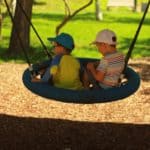ASSESSING PARENTS AND CHILDREN: SIMILARITIES AND DIFFERENCES
On many of the occasions where I have assessed both parents and their children, I have been fascinated by the results. Here are two examples.
Many years ago, I assessed a father and son. Both had a high incidence of gifted scores, were left-handed, and had significant hidden visual perception issues. In the case of the father, the vision issues didn’t prevent him from becoming a good reader. He attained good scores in English literature, qualifying to be a teacher and entering a Master’s program. The son, whose visual perception problems were all in the same areas, but who scored at a lower level in them, almost didn’t graduate from Grade 13 because of his reading and writing difficulties.
Both excelled in mathematics and symbolic thinking. The father eventually entered business as a financial adviser and the son, who had never read a novel or written a report without assistance, became an engineer. Both were very successful.
When I was managing an SOI/IPP program in an alternate school here in Vancouver, I assessed three members of one family. The mother was SOI assessed as she was being trained to help with the IPP program. The two siblings that were tested were attending the school and taking IPP training. The mother was left-handed. Both the son and daughter were right-handed but tested as having ‘left dominance’.
The mother scored at a gifted level in ten abilities. Her only below average scores were related to visual perception, with two scores very low and two low average. She excelled in reading comprehension, math, and organizational ability.
Her daughter Sally, who was in Grade 5, scored below average on the prerequisites for reading comprehension. Three visual perception scores were very low including the ability to sound out words and read aloud. The mother and the regular school system considered her a non-reader. The rest of her scores were average or above with logical thinking at a gifted level. Fortunately we were able to do a physical screening with IPP and picked up on four hidden vision issues:
- problems with eyes holding a focus
- eye-tracking issues
- eyes that didn’t team together
- eyes that didn’t shift between seat work and board work easily
As these visual areas were exercised by IPP exercises, and as Sally improved visual perception through brain exercises, she eventually came up to speed in her reading abilities.
On the SOI assessment, her brother Craig showed none of the visual perception issues that we were seeing in Sally and her mother. However, the IPP assessment uncovered two vision issues that were problematic (moderate to severe) in eye focusing and eye tracking. Additionally, Craig had signs of minor auditory processing problems and written output. Only two of his SOI scores had been below average, and yet he had been failing in school.
Both children successfully finished their SOI/IPP programs seven years ago. Craig went back to regular school and received a scholarship to Simon Fraser University. Sally just graduated from regular high school with good marks and has been accepted into a two-year program at Capilano University where she will be pursuing her dreams of making a difference in the world.
I have always disliked the implication in saying, “The Apple Doesn’t Fall Far from the Tree” – that children’s problems are inevitably linked to their parents. Yet there is a positive side. In the case of SOI assessment, similarities are sometimes startling even as each individual is clearly that – an individual in their own right!
written by: Connie Grist, SOI Associate






